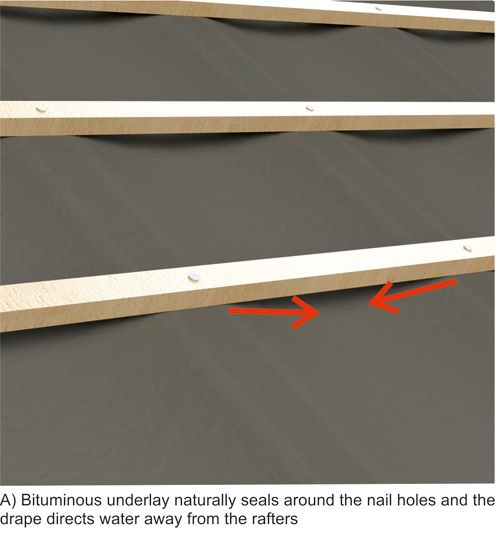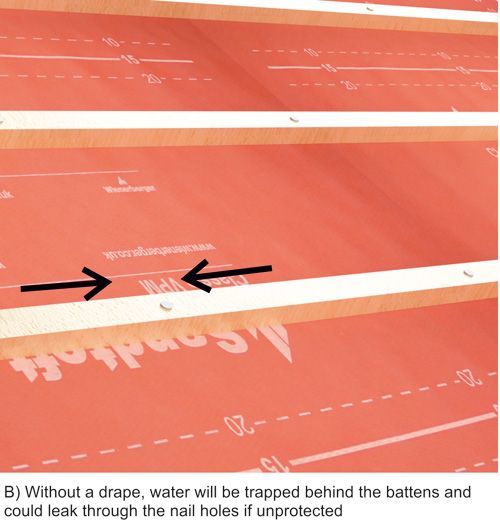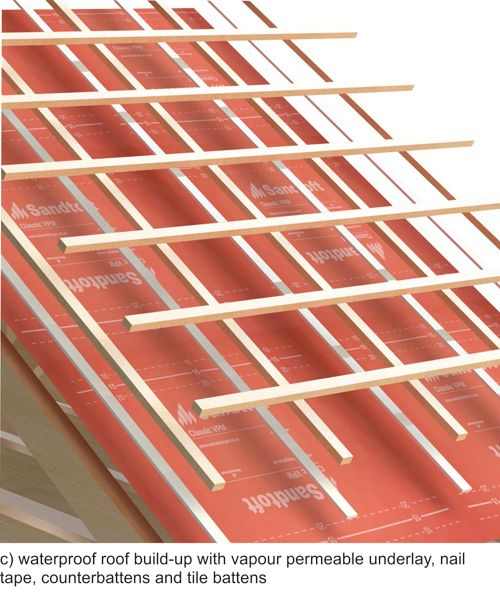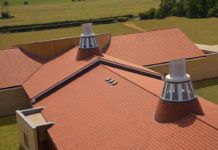


Last month I outlined some of the issues we face when using modern, breathable underlays in achieving a durable and weathertight roof, particularly at low rafter pitches. In this month’s article, I will examine in more detail how to achieve a watertight underlay layer. Next month, I will look at how to detail the various roof junctions.
The issues
Traditional English roof construction practices have served us well for hundreds of years – simple compared to some other countries, but effective nevertheless. The basic cold roof construction consists of rafters set at (up to) 600mm centres, underlay laid horizontally over the rafters, with a slight drape between each rafter and tile battens nailed directly through the underlay into the rafters. The underlay drape allows any water that does find its way into the batten cavity to drain safely away to the gutters.
Bituminous underlay compresses where the battens are fixed over it and forms a watertight seal around the batten and nail hole. The combination of the drape and the sealed holes made for an effective watertight barrier. Modern, lightweight underlays do not compress in the same way, therefore cannot form such an effective seal around the nail holes.
Difficulties for the contractor
Laying the traditional bituminous underlay across the rafters with a drape was easy; in fact, it was impossible to lay it without a drape because it sagged under its own weight – particularly in warm weather. The same cannot be said about modern, lightweight underlays. I know from experience how difficult it can be to get a breathable underlay to drape, especially in even slightly windy conditions. Sometimes it needs someone to hold it down at each end and a third person to fix battens over it before it blows away! The result can be an underlay that is stretched tightly over the rafters without any drape whatsoever.
How to overcome the issues cost-effectively
Having identified the two possible causes of leakage; i.e lack of underlay drape causing water to become trapped behind the battens, combined with the inadequate sealing of nail holes, the solution is to overcome these issues as simply and effectively as possible.
Dealing with the sealing of the nail holes first, if we take the premise that bitumen underlay self-seals around the nail holes, then the simple answer is to re-create that phenomenon. The way we do that is to fit bituminous nail tape between each batten and underlay over the rafter.
Nail tape, as the name suggests, comes in the form of a continuous roll of tape. It is self-adhesive and, as such, it is not practical to simply run it up the underlay over the rafters, as the roofer must stand on the rafters.
The best way to protect the nail tape is to install counter-battens over the underlay and rafters, prior to installing the tiling battens. That way, the nail tape can adhere to the counter-battens and underlay and will create a good seal around the nail holes.
That brings me to the second issue; i.e lack of underlay drape. The counter-battens not only protect the nail tape, they also obviate the need for the drape as they lift the tile battens clear of the underlay, providing an efficient path for water to run under the battens and towards the gutters.
In this application, the counter-battens need only be 10mm deep; that is sufficient to allow water to pass beneath and it satisfies the BS 5534 requirement for a (nominal) 10mm drape between rafters.
The ultimate solution to achieve a very efficient watertight under-roof is to lay rigid sarking board. This is standard practice in many countries, including Scotland, as it provides the ideal substrate on which to construct the waterproof element of the roof.
The underlay can then easily be laid over the sarking, with counter-battens and nail tape fixed over the sarking to coincide with the rafters. To get the full benefit of vapour and air permeable underlays, the ideal sarking is traditional softwood boarding, laid with small gaps between each board.
Of course, sarking adds a significant cost, therefore I simply mention it as worthy of consideration, but it is not essential so long as the other elements I have detailed above are implemented.
Conclusions
What every contractor wants is to do a job as efficiently and cost-effectively as possible, be paid and to not need to go back to rectify complaints. Following these simple recommendations will ensure that each job is a success, first time, with far fewer callbacks. For further information on how to construct a watertight sub-roof, download the Wienerberger Low Pitch Installation Guide here.



